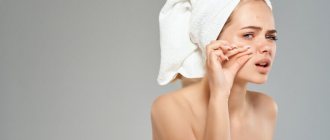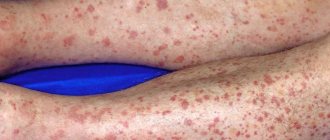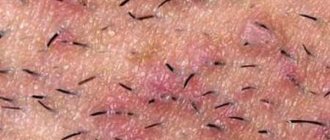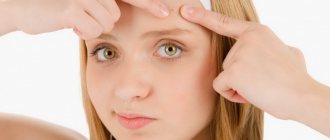- Pimples on the inner thigh Causes
- Blackheads, pimples and acne
- Large cystic acne on the inner thigh.
- Pimples on outer thigh
- Acne cystic between thighs
- Acne on the inner thighs in women Treatment
The pores of the skin secrete an oily substance called sebum, or sebum. It is necessary so that the skin does not dry out, is enriched with oxygen, and receives beneficial substances from cosmetics. If the skin secretes too much sebum and does not receive proper care, the pores become clogged, become wider, and may acne appears. They can form on any part of the skin.
Sometimes, when acne occurs between the thighs, it can even be difficult to walk, swim or run. They can take the form of either white or red pimples, ulcers or boils, develop into a rash on the buttocks, or can appear as separate white and dark spots between the thighs.
Sweating, tight jeans, viral and infectious diseases, bikinis, shaving, hormones, pregnancy and legs rubbing against each other are just some of the reasons why acne appears in the thigh area, more often in women than in men.
Below you will get more information about the causes, treatments and how to get rid of pimples, blemishes and bumps on the thighs quickly.
Clinical picture
Skin rashes (pimples) occur due to blockage of the ducts of the sebaceous glands. The disease manifests itself as:
- small scarlet pimples;
- white dense formations;
- watery transparent blisters;
- large seals.
When scratched, the skin at the site of the rash becomes dry, can become inflamed and peel, and scars and ulcers form on its surface. People of any gender and age are susceptible to pathology.
Ignoring symptoms can lead to infection of the inner layers of the epithelium and sepsis.
Treatments for acne on thighs in men
Drug treatment
What is this? A topical antiseptic used to treat mild to moderate acne.
Presented in: Cleanser, body cream, or lotion Excessive use may cause dry skin.
Benzoyl peroxide is a substance used to treat mild to moderate acne.
Salicylic acid - in the form of a cream, lotion or cleanser Excessive use can cause dry skin.
Tea tree oil is a substance obtained from the leaves of the tea tree. Can be used to combat acne.
Antibacterial agent in the form of lotion, cream, ointment or oil.
Lactic acid is a humectant (increases the amount of water in the skin) - only in lotion form.
Zinc is a particularly important element for the skin with health benefits and components - in the form of lotion or cream.
Use a tea tree oil lotion
Both of these natural oils not only hydrate the skin, but also have antibacterial properties that can help fight one of the causes of folliculitis, trapped bacteria.
Apply the lotion to the buttocks and thighs once a day in the morning or evening. It is best if you apply a thin film of oil to the entire area close to the acne, and not just to the problem spots. Tea tree oil is a powerful natural remedy with an antibacterial effect.
About the results of use and the effect of tea tree oil on acne!
Use lactic acid lotion
Lotions with lactic acid can be useful for moisturizing rough male skin on the thighs and buttocks and treating acne and some causes of folliculitis on it. Be careful with its use and apply it at least once a day. It will take several weeks to notice the results of the treatment.
The lotion typically contains 12% lactic acid and works deep within the skin to provide long-lasting moisture retention and acne treatment. I love this treatment because the lotion is natural and non-greasy with no side effects and I personally use it every time after showering.
Reasons for appearance
There are many reasons why acne appears on the back, front, inner and outer sides of the thigh. Skin rashes are caused by a variety of factors. They may be:
- hyperhidrosis (excessive work of sweat glands);
- inflammatory process occurring in hair follicles;
- hormonal changes during the period of active sexual development;
- allergic reaction to the cosmetics used;
- insufficient adherence to personal hygiene rules, skin contamination;
- lack of air (poor breathability of clothing);
- underwear made from non-natural (synthetic) fabrics.
Factors that increase the risk of disease:
- vitamin deficiency, poor nutrition;
- diseases of the gastrointestinal tract;
- weakness of the immune system;
- parasitic and viral infections;
- drinking water of poor quality;
- sudden change in climatic conditions.
Increased sweating
Occurs as a response to overheating of the body in the summer under the influence of high temperatures or due to unjustified wrapping of the limbs while in a warm room. This is how the body tends to cool down faster. Frequent washing and selection of loose-fitting trousers and dresses made from natural, breathable fabrics (linen, viscose, cotton, wool) will help reduce sweating in the heat.
Folliculitis
Develops as a result of incorrectly performed depilation of the legs. As a result of such manipulation, hairs grow into the skin, the process is accompanied by pain, redness in the problem area, and burning.
Acne or acne
It develops during the active release of sex hormones during the maturation of the body. The area of the face, back, buttocks, thighs, and genitals is often affected.
Cosmetics and household chemicals
Aggressive substances contained in washing powders, shampoos, creams and soaps can lead to an allergic reaction. Allergies can also be caused by the presence of individual intolerance to the constituent components of cosmetics and detergents.
Pimples on the inner thigh Causes
The inner thigh is usually a sensitive area for acne. If you have gained excess weight, there is a chance that there is friction between the thighs, which is causing irritation between them. Symptoms may include red and white spots, sores, boils and acne rashes on the thighs and buttocks.
Sweating
Excessive sweating can lead to acne in different parts of the body. Sweat is produced by the sweat glands in the skin as a way to cool the body when its temperature gets too high. These problems occur in people with impaired sweat glands, as well as during hot periods of the year. The situation can worsen if you wear very thick clothes Excess sweat can clog your skin pores and lead to heat rash and thigh pimples.
Poor functioning of the sebaceous glands
In normal cases, the sebaceous glands located close to the surface of the skin produce sebum, an oily substance that prevents the skin from drying out. But when, due to various reasons, the sebaceous glands are disrupted, it can cause excess sebum, and as a result lead to clogged pores skin, their blockage. Subsequently, the pore in that place becomes black, and when bacteria and dead skin cells enter, an inflamed pimple is formed.
Over time, if no action is taken, more and more sebaceous glands become clogged, leading to the formation of blackheads. These thigh pimples can be treated using skin creams containing 0.5 - 2% salicylic acid or an anti-acne cream 2.5% benzoyl peroxide You can also use retinol cream, synthesized from vitamin A.
Folliculitis
Folliculitis is an infectious inflammatory process at the site of the hair follicle, which has a fungal, microbial, viral origin. At the beginning of the development of the disease, redness and swelling appears in the area of the follicle, in the central part there is a hair, around which a cone gradually forms containing a purulent mass of yellow-green or white in color When this formation is opened and the pus comes out, an ulcer covered with a crust appears. The rash is accompanied by pain and itching of the affected area. The process lasts about one week. With deep lesions, after the crust disappears, scars may remain or increased pigmentation may appear. Usually, folliculitis occurs on face, scalp, groin and armpits, legs and thighs Folliculitis can be treated with antibiotic cream or ointment prescribed by your doctor.
Skin creams
Using oily moisturizers on healthy skin can cause clogged skin pores, and ultimately lead to acne formation. It is always recommended to use water-based moisturizers, which are unlikely to clog skin pores.
Hormonal changes
Acne is most common during puberty, as well as menstruation and pregnancy. Hormonal changes during these phases make the sebaceous glands overactive, leading to clogged pores and the formation of pimples on the thighs.
Friction between thighs
When thighs rub against each other, the friction can irritate the skin on the inner thighs. This can lead to heat rash and clogged skin pores, causing pimples between the thighs. This type of acne can cause itching and tingling.
Keep the painful area clean by washing it with clean water and antibacterial soap. To reduce friction between your thighs, avoid tight clothing. Losing weight and getting rid of excess weight can also help reduce the friction between your thighs. If the pimples are too itchy or painful, apply a warm compress to them 1 or 2 times a day.
Infectious and sexually transmitted diseases
Symptoms of some sexually transmitted diseases (STDs), such as herpes and syphilis, may include pimples in the groin and thighs. Additional symptoms of these infections include fever, headaches, fatigue, blisters, sores, warts. Treatment of sexually transmitted diseases completely depends on the type of pathogen. Depending on the type of pathogen, the following groups of drugs are used to treat sexually transmitted infections:
antibiotics (Spectinomycin, Azithromycin, Tetracycline);
immunomodulators to activate the body’s immune response (Gepon, Immunomax, Immunal);
antiviral agents (Acyclovir, Kagocel, Cycloferon);
hepatoprotectors are used to support the liver in case of severe damage (Essential);
antiparasitic (20% aqueous emulsion of benzyl benzoate, Permethrin);
antifungal agents (Isoconazole, Clotrimazole, Miconazole).
Acne usually goes away after taking medication.
Athlete's inguinal
Athlete's inguinal is usually a fungal infection, known medically as "fringed eczema." Sometimes it is caused by a bacterial (staph) infection. Typically, athlete's foot usually affects the groin, inner thighs, and buttocks due to constant moisture and tight-fitting clothing. the disease is more often observed in adults, in particular in middle-aged men Moist skin provides an excellent habitat for fungi and bacteria Fortunately, in most cases, athlete's inguinal athlete can get rid of it on his own with the help of over-the-counter medications For serious forms of the disease that last more than two weeks, it is best to see a doctor who can prescribe stronger medications for you To treat the affected area, first wash it with soap and water and then apply an antifungal cream Apply the cream slightly outside the affected area to prevent the infection from spreading See a doctor if the infection does not eliminated after treatment within one week.
Acne on the thighs during pregnancy and lactation
Pimples on the skin during pregnancy and breastfeeding spread to different parts of the body. This is caused by hormonal changes. For some women, hormone levels are high during these periods, as well as during menstruation and puberty.
During this time, the sebaceous glands under the skin become overactive. They produce excess oil called sebum. Excess sebum clogs the pores of the skin, causing acne on the back, inner thighs, legs and buttocks.
Keratosis and acne on the upper legs and thighs
If you have scaly pimples or small acne-like bumps on your inner thigh, it may be keratosis pilaris. This is a common skin condition that is not serious and usually goes away by age 30. According to the Mayo Clinic, keratosis pilaris is common on arms, buttocks, upper legs and thighs Symptoms include:
- Rough pimples or growths on the skin
- Small white bumps with white heads
- When irritated and inflamed, they may become red or pink
- Dry and rough skin that may have a sandpaper-like appearance
White pimples on thighs may spread more severely in winter due to lower humidity. When the skin dries out more, the symptoms become more obvious.
Jeans or thick clothing and heat rash
Thrifty Fun and Bold Sky Name Skinny Jeans Cause of Pimples and Thigh Rashes If you love skinny jeans, you can easily get acne, pimples and thigh rashes The reason is that tight clothing irritates the hair follicles in the butt area This leads to pimples on the thighs buttocks, legs and even around the stomach or waist.
Treatment
You can get rid of acne on your skin on your own. But to avoid side effects and unwanted manifestations, you should definitely consult a specialist.
Medicines
Medicines and cosmetics against rashes are prescribed in accordance with the established diagnosis.
The following medications are prescribed:
- "Zinerit";
- "Dalacin";
- Vishnevsky ointment;
- zinc or sulfur ointment (if there are ulcers),
- gel "Skinoren";
- vitamin complexes;
- streptocidal ointment, Amoxil (antibiotics used for inflammation);
- antihistamines (Suprastin, Zyrtec, Zodak) and non-steroidal anti-inflammatory drugs;
- antiseptic lotions, tonics.
Advanced pimples and severe acne are removed using liquid nitrogen. Such manipulations are carried out only in specialized clinics.
Folk remedies
Traditional medicine helps to cope with acne. Effective are:
- Tincture of calendula, chamomile (you can add coltsfoot), aloe juice: they rub the skin in the affected areas.
- Tar soap.
- Turmeric: powder is mixed with vegetable oil in a ratio of 8:5, applied to the problem area. The procedure is carried out every day until complete recovery.
- Garlic. Its juice is used to treat pathological neoplasms. You can make a mask by applying chopped garlic paste to the painful area, previously lubricated with olive oil.
- Sea salt. Warm salt baths are recommended to be taken daily: they soften and soothe the skin.
- Lemon juice, tea tree extract.
- Fir oil.
- A scrub made from shower gel and table salt. Used if there is no inflammation. As a solid component, you can take coffee or ground oatmeal.
- Linen masks: the product is mixed in water until thick, painful areas are lubricated with it, left for a quarter of an hour, then washed off.
Acne on the thighs and buttocks in men, how to get rid of it?
Fortunately, many of the common causes of these annoying red pimples on the thighs and buttocks in men can easily go away with changes to some men's lifestyle habits:
- Wash your buttocks regularly (daily) with antibacterial soap.
- Try using a body wash with a small amount of benzoyl peroxide or salicylic acid added. Dermatologists recommend using
alcohol-free salicylic lotion in this area. Stopproblem. - Wear only clean clothes and underwear, changing them every day, especially immediately after sweating, such as after working out at the gym, and remember to shower and change underwear immediately after exercise.
- Use an ointment or lotion with tea tree oil, which has been shown to have antibacterial properties. Zinc creams (such as calamine lotion) may also be helpful.
- Use hypoallergenic body products and cleansers that are more suitable for sensitive skin and do not contain harsh chemicals or fragrances.
- Moisturize your thighs and buttocks regularly - try a lactic acid lotion to help treat acne-causing bacteria.
- If possible, use clean, cotton clothing and avoid synthetics.
- Avoid sitting in one place for too long and take breaks and walks from time to time.
- Sitting on a hot, damp fabric chair for 30 to 50 minutes can also cause acne on men's buttocks and thighs.
- Drink more water, at least 3 liters, to help flush toxins from your body.
- Whatever you do, don't pop pimples! This can make them even more inflamed and lead to the spread of infection.
How to prevent the spread
To prevent acne from spreading to other parts of the body, the following mandatory rules should be followed:
- constantly take a shower and perform water procedures;
- change underwear daily, wear clothes made from natural materials;
- use only clean and individual bedding and bath accessories;
- take air baths regularly;
- wear loose, breathable clothing;
- if you sweat heavily, you can use baby powder;
- after completing peeling and scrubbing, disinfect the skin surface with a chlorhexidine solution;
- take herbal baths based on chamomile, St. John's wort, calendula (you can apply ice to the affected areas);
- eat right: eat fruits and vegetables, exclude flour, sweets, soda; drink plenty of water.
To completely remove acne, you need to eliminate the factor that caused it.
Pimples on outer thigh
Small red bumps on the skin, even if they are not itchy or painful, can be quite alarming. Since red bumps can appear on the outer thighs for a variety of reasons, it is important to first determine the cause of their appearance before trying to treat them.
Depending on the cause of thigh acne, some can be eliminated or reduced on your own at home with proper skin care routines. More serious cases may require the help of a doctor.
Folliculitis, or inflammation of the hair follicles, can form on the thighs due to improper shaving, infection, or irritation from clothing. It causes red pimples, similar to normal ones, with hair in the center. This results in many small skin pimples that resemble goose bumps.
This condition is often accompanied by dry skin. Cholinergic urticaria occurs as itchy pimples after exercise, heavy sweating, or exposure to heat or hot water. These pimples can be small, like mosquito bites, but can also appear in large sizes.
Prevention
Preventive measures to prevent the appearance of acne on the thighs in women and men are to:
- keep the body clean at all times;
- in case of severe sweating, especially in summer, it is necessary to perform water procedures several times a day;
- wear loose, ventilated natural clothing;
- Healthy food;
- regularly eat fresh vegetables and fruits;
- Avoid infections and contacts with people suffering from this pathology.
It should be remembered that pimples on the thighs can be an indicator of diseases of the internal organs. To exclude the presence of skin pathologies and the possibility of developing serious complications, when the first alarming signs appear, you should consult a dermatologist.
Large cystic acne on the inner thigh.
A large pimple on the inner thigh could be cystic acne. According to clinical studies, cystic acne affects people between the ages of 8 and 50. These bumps are characterized by large red bumps on completely different areas of the skin. They are not as common on the thighs as regular acne, but they are also may occur in severe cases of acne.
Painful pimples in the groin area caused by cystic acne are red, deep bumps and boils. While most small pimples and bumps can go away on their own after some time, cystic boils do not go away as easily or unnoticed as they appear. They may recur or last for years, and may also leave scars on your thighs after you get rid of them.
Pimples on thighs
Preventive measures
If the causes of pathological formations are known, then their occurrence can be prevented using simple preventive measures:
- Give preference to loose clothing. Tight trousers and jeans impair air circulation. Tight, tight-fitting clothes promote increased sweating and the accumulation of dirt in the pores. Dirt and sweat clog the excretory ducts and the mouths of the follicles, which leads to the appearance of pimples on the buttocks.
- Maintaining hygiene. In hot weather, the number of water procedures is increased. Minimize the use of oil cosmetics.
- Dieting. Almost completely exclude fried, smoked, spicy foods. Increase consumption of fruits and vegetables.
If you have chronic diseases that cause a rash on your thighs, you need to be examined regularly.











